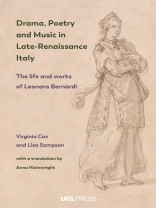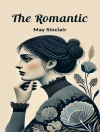Leonora Bernardi (1559-1616), a gentlewoman of Lucca, was a highly regarded poet, dramatist and singer. She was active in the brilliant courts of Ferrara and Florence at a time when creative women enjoyed exceptional visibility in Italy. Like many such figures, she has since suffered historical neglect. Drama, Poetry and Music in Late-Renaissance Italy presents the first ever study of Bernardi’s life, and modern edition of her recently discovered literary corpus, which mostly exists in manuscript. Her writings appear in the original Italian with new English translations, scholarly notes, critical essays and contributions by Eric Nicholson, Eugenio Refini and Davide Daolmi
Based on new archival research, the substantial opening section reconstructs Bernardi’s unusually colourful life. Bernardi’s works reveal her connections with some of the most pioneering poets, dramatists and musicians of the day, including her mentor Angelo Grillo and the first opera librettist Ottavio Rinuccini. The second major section presents her pastoral tragicomedy Clorilli, one of the earliest secular dramatic works by a woman. It was apparently performed in the early 1590s at a Medici villa near Florence, before Grandduke Ferdinando I de’ Medici, and his consort Christine of Lorraine, but now exists in an enigmatic Venetian manuscript. The third section presents Bernardi’s secular and religious verse, which engaged with new trends in lyric and poetry for music, and was set by various key composers across Italy.
Praise for Drama, Poetry and Music in Late-Renaissance Italy
‘This volume sets a fresh standard for how modern scholarship should be done ….A truly interdisciplinary and thorough presentation of a hitherto understudied figure and her literary output, which sheds new light on the cultural landscape in late Renaissance Italy.’
Modern Language Review
‘The untold full story of a poet, playwright and musician whose life and works offer unique insights into the culture of late Renaissance court society. A must-have for scholars working at the intersection of poetry, music and theater. A treasure trove of new information and fresh perspectives. A remarkable achievement and a model of interdisciplinary collaboration.’
Giuseppe Gerbino, Columbia University
‘Cox and Sampson continue their pioneering work on women writers in early modern Italy. Leonora Bernardi rose above the scandal of the abrupt ending of her marriage by her adroit handling of patronage networks and literary connections. Her Clorilli was an important contribution to the new genre of pastoral tragicomedy. She demands a truly interdisciplinary study, and this book is a model of its kind.’
Tim Carter, University of North Carolina at Chapel Hill
Tabla de materias
List of figures and tables
List of contributors
Abbreviations
Acknowledgements
1 Context, life, legacy
Virginia Cox
1.1. Context
1.1.1. A troubled city: Lucca in the Cinquecento
1.1.2. Poetry, music and spectacle in Lucca
1.1.3. Women’s participation in Lucchese cultural life
1.2. Life
1.2.1. 1559-79: Girlhood and marriage (Lucca, Castelnuovo)
1.2.2. 1579-84: Married life (Lucca, Florence, Ferrara)
1.2.3. 1585-88; Widowhood, scandal, banishment (Ferrara, Lucca, Florence)
1.2.4. 1588: Poetic rehabilitation (Florence)
1.2.5. 1589-98: Exile (Florence, Ferrara)
1.2.6. 1599-1603: The ridotto years (Lucca)
1.2.7. 1603-16: Religious retreat (Lucca)
1.3. Legacy
1.4. Conclusion
1.5. Appendix: Documents of the scandal of 1588
2 Clorilli and late-Renaissance theatre
2.1. Bernardi’s Clorilli and pastoral drama between Ferrara and Florence
Lisa Sampson
2.1.1. Pastoral drama: The Ferrarese tradition
2.1.2. Court and academies in Ferrara
2.1.3. Bernardi’s Clorilli: Structure and themes
2.1.4. Bernardi’s pastoral in Florence: Contexts of performance
2.1.5. Female pastoral in Florence: Drama, poetry and music
2.2. The Marciana manuscript of Clorilli
Lisa Sampson
2.2.1. Authorship, anonymity and agency
2.2.2. The production of the Marciana manuscript
2.2.3. The diverse rime
2.2.4. Reception and transmission of Clorilli (Florence, Lucca and Venice)
2.2.5. Appendix: The Codex Biblioteca Marciana, Venice MS It. IX, 239 (=6999)
2.3. Clorilli, A Pastoral Tragicomedy: A bilingual annotated edition
Lisa Sampson and Anna Wainwright
2.4. Green acts in green shades: Adapting and staging Clorilli at Villa La Pietra, Florence, 2018
Eric Nicholson
2.4.1. Green worlds
2.4.2. Water
2.4.3. Rejections, separations and confrontations
2.4.4. Projections and reunions
2.4.5. Fusion, renewal and community celebration
3 Bernardi’s lyric verse and its musical settings
3.1. Leonora Bernardi, lyric poet
Virginia Cox
3.1.1. Sources
3.1.2. The Marian Muse
3.1.3. In dialogue with Leonora Bernardi: Angelo Grillo
3.1.4. In dialogue with Leonora Bernardi: Ottavio Rinuccini
3.1.5. Songs of love
3.2. The musical settings of Bernardi’s verse
Eugenio Refini
3.2.1. Ferrarese echoes in madrigal settings of Bernardi’s poetry
3.2.2. Bernardi’s ‘tears’ across polyphony and monody
3.2.3. Sienese connections and textual variants: The nymph’s canzonetta
3.2.4. Transcriptions of the musical settings
Davide Daolmi and Eugenio Refini
Bibliography
Index
Sobre el autor
Anna Wainwright is Assistant Professor of Italian Studies and Core Faculty in Women’s and Gender Studies at the University of New Hampshire.












